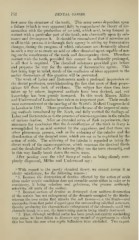Page 742 - My FlipBook
P. 742
752 DENTAL CARIES. : — ;
first enter the structure of the tootli. This error seems dependent upon
a faikire (which is very apparent) fully to comprehend the theory of fer-
mentation with the production of an acid, which acid, being formed in
contact with a particular part of the tooth, acts chemically upon its sub-
stance and decomposes it. It should be remembered that if microbes act
at all in this process it is through their agency in setting up fermentative
changes, during the progress of which substances are chemically altered
in such a way as to create an acid or other chemical agent capable of act-
ing on the constituents of the tooth and decomposing them. Therefore
contact with the tooth, provided this contact be suiftciently prolonged,
is all that is required. The chemical substance provided goes before
and prepares the way for the entrance of fermentative agents. This
fact being kept in mind, much of the confusion of ideas apparent m the
earlier discussions of this question will be prevented.
The work of Leber and Kottenstein made a profound impression on
the dental profession, notwithstanding the fact that most of their propo-
sitions fell from lack of evidence. The subject has since then been
taken up by others, improved methods have been devised, and our
knowledge has been greatly increased. In this work Messrs. Milles
and Underwood of London have taken an important part. Their results
were communicated at the meeting of the World's Medical Congress held
in London in 1881. These gentlemen had the use of the improved stain-
ing methods introduced by Dr. Koch, and fully verified the findings of
Leber and Rottenstein as to the presence of micro-organisms in the tubules
of carious dentine. After an extended series of flask experiments, they
announce the conclusion that the decalcification of the teeth in decay is
accomplished by an acid secreted by the organisms, and that there are
other phenomena present, such as the widening of the tubules and the
discoloration of the decayed mass, which are not to be explained by the
action of acids. The widening of the tubules is regarded as being the
direct work of the micro-organisms, which consume the dentinal fibrils
and the decalcified walls of the tubules (they use the term channels), and
in this way finally break down the entire mass.
After passing over the vital theory of caries as being already com-
pletely disproved, Milles and Underwood say
" With regard to the purely chemical theory, we cannot accept it as
wholly satisfoctory, for the following reasons :
" 1. Because the destruction of dentine effected by the action of acids
alone under aseptic conditions does not resemble caries either in color or in
consistency, it being colorless and gelatinous, the process uniforrply
attacking all parts of the surface.
" 2. Because sections of dentine so destroyed show uniform destruction
of the matrix, but not enlargement of the channels occupied by the fibrils
whereas the true caries first attacks the soft tissues i. e. the fibrils—and
encroaches from that point d'appni upon the surrounding calcified structure,
thereby producing the characteristic enlargement of the channels, until tAVO
channels break into one, the intervening matrix being wholly destroyed.
" 3. That, although artificial caries has been produced exactly resembling
true caries, we have failed to discover any record of experiments in which
this has been the case when septic influences were excluded. Two experi-


